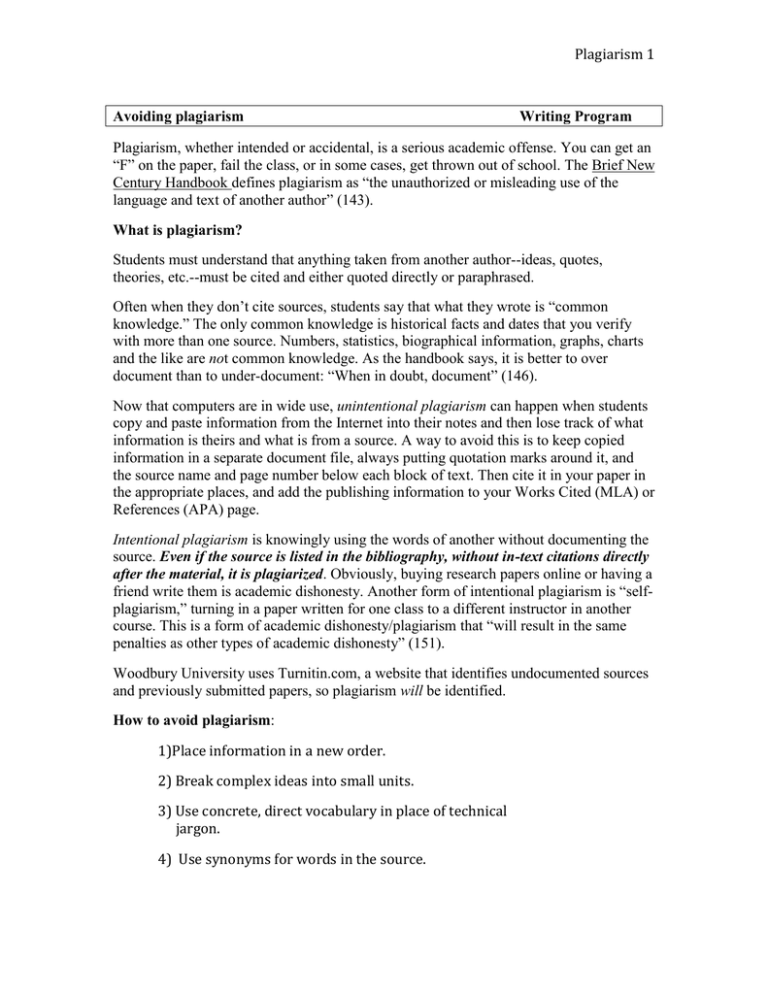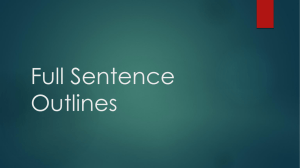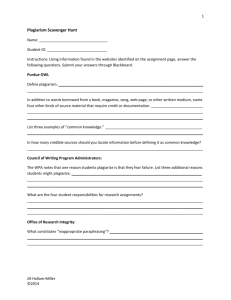
Plagiarism 1
Avoiding plagiarism
Writing Program
Plagiarism, whether intended or accidental, is a serious academic offense. You can get an
“F” on the paper, fail the class, or in some cases, get thrown out of school. The Brief New
Century Handbook defines plagiarism as “the unauthorized or misleading use of the
language and text of another author” (143).
What is plagiarism?
Students must understand that anything taken from another author--ideas, quotes,
theories, etc.--must be cited and either quoted directly or paraphrased.
Often when they don‟t cite sources, students say that what they wrote is “common
knowledge.” The only common knowledge is historical facts and dates that you verify
with more than one source. Numbers, statistics, biographical information, graphs, charts
and the like are not common knowledge. As the handbook says, it is better to over
document than to under-document: “When in doubt, document” (146).
Now that computers are in wide use, unintentional plagiarism can happen when students
copy and paste information from the Internet into their notes and then lose track of what
information is theirs and what is from a source. A way to avoid this is to keep copied
information in a separate document file, always putting quotation marks around it, and
the source name and page number below each block of text. Then cite it in your paper in
the appropriate places, and add the publishing information to your Works Cited (MLA) or
References (APA) page.
Intentional plagiarism is knowingly using the words of another without documenting the
source. Even if the source is listed in the bibliography, without in-text citations directly
after the material, it is plagiarized. Obviously, buying research papers online or having a
friend write them is academic dishonesty. Another form of intentional plagiarism is “selfplagiarism,” turning in a paper written for one class to a different instructor in another
course. This is a form of academic dishonesty/plagiarism that “will result in the same
penalties as other types of academic dishonesty” (151).
Woodbury University uses Turnitin.com, a website that identifies undocumented sources
and previously submitted papers, so plagiarism will be identified.
How to avoid plagiarism:
1)Place information in a new order.
2) Break complex ideas into small units.
3) Use concrete, direct vocabulary in place of technical
jargon.
4) Use synonyms for words in the source.
Plagiarism 2
5) Accompany each important fact or idea in your notes
with the source page number.
6) Incorporate the paraphrase smoothly into the grammar
and style of your own writing.
7) Document all paraphrases.
Students should avoid quoting too much. Quotes should support your argument, not make
it for you, and they must be introduced properly with signal phrases, such as: “Christine
Hult believes that students, „need to use signal phrases to alert [their] reader that a
quotation is coming‟” (160). And the quotation needs to be attributed with the page
number, or paragraph, if the source is a webpage.
If you have any doubts about how to document sources, or for more help identifying and
avoiding plagiarism, see pages 143-164 in your handbook or ask the writing center for
help.
Source: The Brief New Century Handbook, by Christine A. Hult and Thomas N. Huckin,
Pearson Longman, 2008







